
Scott Bristol's 'Values@Hand'.
Summary. Drawing on academic literature, a ‘worldview’ is recognized as a general classification of a set of values that influence individual or group behavior and that explains similarities and differences between cultures or sub-cultures. 'Worldview' as a general concept is here behaviorally defined according to LJMap's values measurement and mapping methodology as two different basic concepts: 'natural worldview' and 'developmental worldview'. Each of these two concepts in turn is defined at the specific level creating a clear methodology for 1) measuring difference between individuals and groups, and 2) measuring change over time for an individual or group. The 'natural worldview' is defined in terms of its potentially emergent properties more in line with self-organizing behavior, thus moving away from a fixed 'personality' like construct. This shift in definition also applies to the concepts of 'culture' and 'sub-culture'. A developmental continuum is presented that integrates research in 'linguistic-development', 'perceptual-development', and 'spiritual development'. LJMap's 'developmental worldview' organizes value words on a prototypical 'construction of ego'.....'de-construction of ego' continuum allowing for 3) measuring developmental difference & change over time. The over all purpose of this effort to make 'worldview' a more specific concept that better facilitates measuring, mapping, and influencing individual or group 'change in meaningful problem solving languaging' over time.
Worldview initially conceptualized by Anthropology and Sociology describes a set of cognitive and affective elements that exist prior to and influence behaviors.
Max Scheler originally used the term ‘relativnaturliche Weltanschauung’-relatively natural worldview (Berger & Luckmann, 1966, p8).
Rapport (1993) in his ethnographic study confirmed the fluidity of ‘natural worldviews’ in an English village where he found a multitude and diversity of personal worldviews, both within and between individual psyches.
Three fundamental characteristics extrapolated from Scheler's and Rapport's works and observations will be used to formulate a more dynamic conceptualization and utilization of worldview:
These three characteristics will be used to define how to LJMap measures qualitative and quantitative difference, change, and prototypical difference & change as it applies to 1) natural worldviews, and 2) developmental worldviews.
Embodied realism or embodied cognition, is the school of cognitive science and neuroscience that asserts that the world as we know it contains no primary qualities. Humans experience the world the way they do because of their neural makeup, our bodily interactions with the world (cognitive, affective, and physical), and our purpose and interests (Lakoff & Johnson, 1999).
Affording is how humans make available meaningful properties of the environment as perceivable objects. "Affordances consist in the opportunities for interaction that things in the environment possess relative to sensorimotor capabilities of the animal" (Varela, Thompson, & Rosch, 1996, p.203; James Gibson, 1986). According to Eleanor J. Gibson, and her extensive research in perceptual-development; affording is exploring and differentiating perception compelled by an individual's effort toward meaning or making sense of the world and results in change and development. Perception and action are integral; we perceive in order act, and act in order to perceive (Eleanor Gibson, 1969,1975,1991,2000).
Affording explains 'how' and 'why' humans 'perceive objects'. This is congruent with, and extends, the underlying definition that values are states of intentionality. The next four steps address our human capacity for cognitively processing, remembering, and manipulating different numerical sets of differentiable objects.
Consequently, 'order in the world' or 'categories' are not an inherent quality of the world but a consequence of human's finite capacity to perceive, label, remember, manipulate, and attend to a set of objects within a 'domain of competency'- an area of purpose and expertise. Recognizing the limitations and dynamics of human consciousness- 16 bits/sec (Nørretranders, 1991;Simon, 1996), specific numbers and characteristics can be used to more clearly define these four dynamics that are the building blocks of consciousness, categorizing, and learning.
1) Co-processing. Humans can co-process 3-4 objects at once. This capability is called subitizing and is evident in new born babies (Lakoff & Núñez, 2000, p.19-21; Simon, 1996, p.69 ).
2) Sequencing. Humans sequentially can hold in there short term interactive memory 7 ± 2 objects (Miller, 1956).
3) Natural Memory. Within a domain of competence humans have the capacity to naturally label and remember up to 500 different objects. Building on Claude Lévi-Strauss's (1962, p.153-4) initial hypothesis, Berlin found that "both ethnobotanical and ethnozoological systems of classification have an upper threshold of generally five hundred or so named folk genera". This conclusion was based on his review of "17 relatively complete systems of ethnobotanical classification" from different linguistic groups of natives on how they naturally labeled their fauna and flora (Berlin, 1992, p.98).
4) Chunking. Humans use co-processing and sequencing to compress 2-9 objects into a single object that they can more easily remember, recall, and manipulate. For example we chunk or compress 'letters' into 'words'; in the average English text there is about 5.5 letters per word (Pierce, 1980).
Much of learning tacitly involves these dynamics, imitating and practicing the culturally evolved rules of chunking and unchunking (compressing and decompressing) information. Tomasello (1999, pp 37-40) calls this type of cultural learning, in which humans modify existing artifacts (i.e. language, tools, etc) and pass on innovation via incremental modification of chunking rules the 'Ratchet Effect'.
“All habitual skills operate via compressed information with minimal ratio of conscious reports to messages and with minimal affect”. (Tomkins, p.81, 1991)
Learning to read and write is one example of a cultural artifact that has been modified over centuries. Yet, for each generation there is stable set of chunking-unchunking rules that humans must learn to read and write.
Application of 'Mechanics of Object Memory and Manipulation'. LJMap's value definitions and values ranking measurement methodology is built around these mechanics.
For example: the value Honest, as measured, is defined as "Being honest, truthful, and candid."
Chunking/Compression sequence: letters > words > 3 word set > 1 value> 4 value set> rank order set .
LJMap Definition: A Natural Worldview is an emergent categorization created by an individual. It is a sub-set of a full domain of values, meaningful to the individual or group, that emerges from individual's values ranking(s) of said full domain of values. As defined the natural worldview allows for the measuring difference and change.
Starting with a set of basic assumptions congruent with the above discussion it is possible to depict a Natural Mapping of 130 Values (Fig 1). The intent of this map is to help the reader better understand our human capacity to remember and apply a large number of different variables within a domain of competence. And to realize that it is common for measurement methodologies to reduce this complexity to only 1-9 variables, for example:
LJMap challenge's this approach of collapsing or compressing a "comprehensive set of all possible measures", a full domain of sorts, into a priority set- "two major dimensions emerged that organized into four main clusters". In doing this the author's shifted their 'languaging change', from specific level language to basic level language. In doing this they achieved basic level orientation but lost specific level change language. In fact LJMap asserts that the predictor of individuals and groups to create shared meaning is based on the degree of common Field of Meaning values, their top 34 values. Consequently measuring and strategizing change also needs to operate at the 34 variable level, not the 4 variable level.
LJMap's quantifies these concepts accordingly:
The Field of Meaning is a construct that can be used to measure 1) difference between individuals and groups, or 2) change in an individual or group over time. A 'group' in this context can also represent a natural worldview, a culture, or a sub-culture depending on the size of the group and membership qualities.
Measuring difference or change involves the following testing.
1) Individual vs. Individual. Two individuals A &B, may have different size Field of Meanings comprised of different values. Or over time an individual's Field of Meaning may change in size. So two different value sets must be tested for significant difference:
2) Individual vs. Group. The same dynamic can be used to test difference between the individual's Field of Meaning and the Group's Field of Meaning.
3) Group vs. Group. The same dynamic can be used to test for difference between the two different Group's Field of Meaning, or a change over time in a given Group's Field of Meaning.
LJMap Definition: A Developmental Worldview is a prototypical categorization and as such a social construct. It is a sub-set of a full domain of values grouped and sequentially organized by an observer (researcher) to facilitate measuring and mapping difference and change for individuals or groups. As defined a developmental worldview allows for the measuring developmental difference & change according to the pre-established prototypical category continuum.
"The judged best examples of conceptual categories are called prototypes" (Rosch, 1999, p.67). ‘Prototypes’ are human categories, concepts as neural structures, built on experience that permit us to do some sort of inferential or imaginative task relative to a category: 1) draw inferences about category members in the absence of contextual information; 2) evaluate category members relative to some conceptual standard (Lakoff & Johnson, 1999). As such, prototypical categorizing are ways in which humans as observers linguistically organize and inter-relate objects present in their world. Prototyping is influenced by our human dynamics and constraints of affording, subitizing, sequencing, natural memory and chunking.
Research has shown the use of prototypical categories in languaging influences 1) speed of learning, 2) speed of judgment, 3) speed of association, 4) speed of inference, 5) probability judgments, 6) natural language of graded structures, and 7) judgment of similarity. Concepts as such are not representational nor in isolation. Concepts have a participatory, not an identifying, function in situations (Rosch,1999). The importance of good 'prototyping' is that the use such concepts in languaging facilitates speed and efficacy of meaningful problem solving.
Applying these learnings of categorization to organizing values on a developmental continuum means that efficacy of the construct is not in does it 'fit an external world', the embodied cognition and the prototypical framework rejects this representational expectation. The criteria for validity is whether this languaging and measuring of categories generates 1) pattern similarity and difference that 2) help explain and predict human ability to influence meaningful languaging within and across individuals and groups. Efficacy is not in describing 'the' world. Efficacy is describing 'a' world we can cooperatively influence via languaging.
Recognizing that languaging is about simultaneously describing and cooperatively influencing our world (Rosch,1999). The creation of a measurement model for values developmental involves the use of prototypical categories to facilitate languaging about how humans change over time (as an observer of change) and how we use language to influence human change over time (as an influencer of change).
Miller (1993, p.4-8) asserts what is critical about a developmental theory is it focuses on change over time. Three different tasks address this concern.
Three common goals of a developmental theory are description, prediction-control, and explanation. Different sets of explanatory principles or processes are used to achieve these goals, they include biological, cognitive, affective, learning, and social interactional processes.
In a 100 year review of developmental psychology Parke et. al. (1994) and Miller (1993) identify 18 different key contributors to the field: Charles Darwin, G. Stanley Hall, James Mark Baldwin, John Dewy, Alfred Binet, Sigmund Freud and René Spitz and Erik Erikson, James B. Watson, Jean Piaget, Heinz Werner, William L. Stern, Lev Semyonovich Vygotsky, Arnold L. Gesell, Myrtle B McGraw, John Bowlby and Mary Ainsworth, Robert R. Sears and Albert Bandura, Nancy Bayley, Eleanor J. Gibson, Konrad Lorenz and Niko Timbergen and E. O. Wilson. In a more recent review of developmental research Slater and Muir (1999) present 39 papers that "cover the whole range of developmental psychology". Only 3 of the papers are from the previously list of researchers.
The point being that the field of human development is dynamic and diverse, and as Slater and Muir (1999, p.1-6) point out, different developmental theories in themselves represent different word-views. The goal here is to identify the research that gives credence and guidance to Life Journey Maps® methodology for categorizing and sequencing a developmental worldview of value words. An to note and/or include what is missing.
Maturana and Varela in their classic work, The Tree of Knowledge: The Biological Roots of Human Understanding (1987) apply their autopoietic system theory to the explanation of evolutionary development from 'single cell organisms' up to 'languaging social systems'. The purpose for drawing on this work is that it includes the theoretical foundation for 'self-referential systems theory' (Maturana and Varela,1970; Luhmann, 1990; von Foerster, 2003), and 'circular set theory' (Barwise,1996; Devlin,1993). When ever we talk about behaviors like 'self-awareness', 'self-control', and 'learning-to-learn' or refer to a dynamic that is influenced by what is 'meaningful' to the organism we posit some ability of said organism to make a 'self-referential choice'. Also, philosophers (Lewis,1969; Searle,1983; Grice,1966) have noted that languaging, intentionality, and meaning appear circular and self-referential.
Most of the developmental theorist, presented above, focus on the interaction of three different agents of change: biological, environmental, and/or social-cultural-historical. A fourth agent, meaningful choice, is often left out. The dynamic of choosing, be it conscious or unconscious, by its very nature is self-referential and cannot be explained by the biological , environmental, and/or social-cultural-historical dynamics.
It's not that the dynamic of human choice has not been noticed; the experiments of Jerome Bruner (1968) have shown that, very early on, the infant replaces the reflex sucking by beginning to suck voluntarily, and this is discriminably different from reflex sucking.
Open systems theory, applied to social systems, initially focused on input-output dynamics for maintenance and production (Katz & Kahn, 1966). More recently systems theory has evolved to include self-referential dynamics that are not addressed in input-out put systems theory. Autopoietic systems theory attends to the importance of self-referential feedback loops that maintain structural unity while still being able to change and adapt in 'affordance' with meaningful, biological, environmental, and social opportunities via structural coupling.
Different feedback symbols:
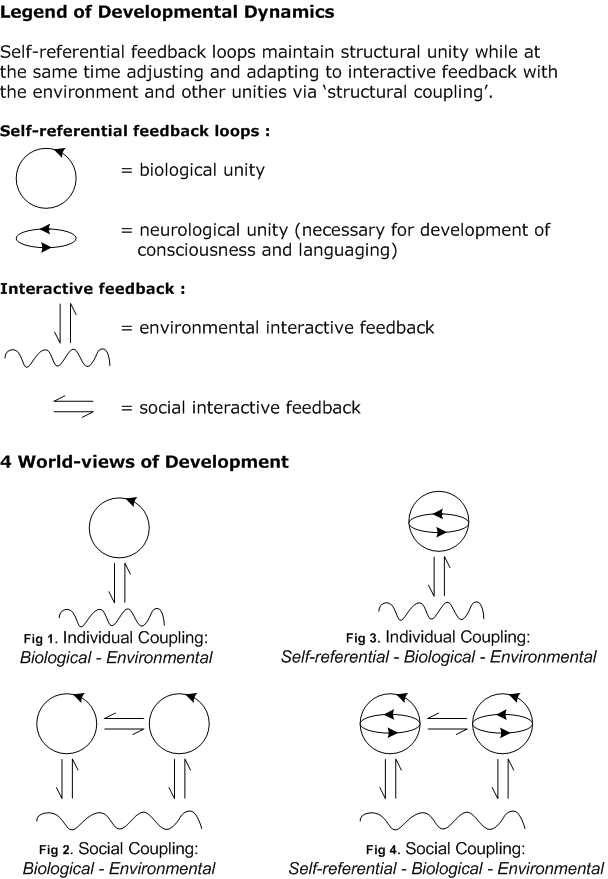
Inherent in these depicted '4 Worldviews of Development' are four agents used to explain developmental change:
Fig 1 depicts developmental theories that focus on how an individual's interaction with their environment is influenced by biological change and in turn how the environment influences biological change, e.g. Piaget's theory of cognitive development.
Fig 2 depicts development theories that focus on interaction of two similar unities, in this case the influence of humans on humans, and the individual's interaction with their environment as influenced by biological change and in turn how the environment influences biological change. Many schools of development, in their failure to included human choice (self-referential unity), fall into this category. Freudian development, in that it is driven by the reduction of biological urges falls into this category. Both generations of the Social Learning School of development, including Watson, Skinner, Hull, Sears and Bandura; the Information School and Ethnology School (E. O. Wilson, Konrad Lorenz, Niko Timbergen) as utilized in 'Attachment Theory' of Bowlby and Ainsworth; the Contextualist School (e.g. Vygotsky) makes culture, the interactions between humans and a specific environment, the unit of study.
Fig 3 depicts the necessary feedback loops for a self-conscious unity that can sustain meaningful choosing. Eleanor Gibson in her extensive research on 'perceptual development' with pre-linguistic children consistently worked from a 'worldview' that "perception involves an effort toward meaning or making sense out of the world" (Parke, et al., 1994, p.534).
Fig 4 depicts the necessary feedback loops for 'self-conscious' unities to develop 'languaging' (Maturana & Varela, 1987,p.176). Research in the area of 'language development' by Tomasello (1999, 2003) and Gopnick & Meltzoff (1998) fits this diagram. Also The Life Span school of development that addresses the 'birth to death' journey and the choices humans make to sustain personal meaning during this journey fit this framework. Erickson, Kohlberg and Gilligan, fit here to the degree that they frame their developmental steps as choice points. 'Spiritual developmental' is another framework provided by the writings included in enduring religions (Huxley, 1944; Fowler, 1981; Hall, 1986). As such they present a social construct for stages of development that have cross cultural validity and thousands of years of documentation.
The Life Journey Map's® measures and maps individual or group change in meaningful problem solving languaging over time. Value words are prototypically categorized and sequenced along a developmental continuum according to these four principles:
Lakoff and Johnson’s 30 years of study and research in language shows that metaphor and imagination emerges from our embodied experience and underlies the very logic and workings of all languages. Aware and intentional use of metaphor as a guide to our use of language, logic and experience is fundamental to Life Journey Map® measurement, theory, and practice.
In our western culture ‘A Purposeful Life is A Journey’ is a profoundly influential complex metaphor build around two primary metaphors (Lakoff & Johnson, 1999):
By accepting these metaphors we create a cultural belief and expectation that people are supposed to have a purpose in life, and they are supposed to act so as to achieve their purpose.
One of the entailments of this metaphor is that good maps facilitate journeys. Accordingly, we evaluate each other and our self on our progress according to movement on our map towards our destination or purpose. If you don’t have purpose in life you are “lost”, “without direction” (a Western bias). This raises an interesting question, “Is developmental psychology influenced by this same metaphor?” Its important to recognize that there are cultures in the world where this metaphor does not exist. LJMap's approach to values development is that we are influenced by choice and opportunity.
In 1986 an “Inner Science Conference” was held at Amherst College (MA, USA) focusing on Western Psychology and Eastern Mind Science. The Dalai Lama was the guest speaker along with a number of well-known western psychologists and scholars. A conclusion of the conference was that western psychology’s strength lies in its understanding of the dynamics necessary for the creation of a ‘self’. Where as, the strength of eastern thought (Buddhism) lies in its experiential approach and practices to spirituality and the realization of ‘no-self’ (Sunyata). Thus the 'construction-deconstruction' continuum for human development.
The integration of these two fields of thought, both grounded in experiential self-discovery, was best expressed by a journey metaphor that emerged from this conference: “You have to become somebody before you can become nobody”. This quote is important as a means for integrating culturally different life journeys: purpose-no purpose, or self-no self. It has cross-cultural face-validity by its very origin. It summarizes the Life Journey Map's® 'construction of ego'-'de-construction of ego' continuum. This approach is congruent with Mihaly Csikszentmihalyi's cross cultural review of models of human development: “In each case, progress means freeing oneself from genetic commands, then from cultural constraints, and finally from the desires of the self… until at the most advanced levels the autonomous individual ends up blending his or her interests with ever larger groups”(1994 p.161). This journey metaphor and its entailments was intentionally selected as a way to organize and integrate LJMap’s approach to values, culture, and meaning.
Stories are metaphors that demand purpose and meaning, it is inherent in their creation, structure and use. The use of stories to the give specific value definitions day-to-day relevancy, coach individuals, and explain different value paths constantly revisits and invites us to discover or create meaning.
Stories are holistic and integrative. Our sense of ‘self’ is but an ongoing story- a linking of discrete events into a whole, that we sub-vocally and vocally have been telling others and our-self, as well as replaying visually for our-self, for years. In this way stories are a consequence of our gestalt perceptual tendency to organize our experience in ‘wholes’.
Building on the journey metaphor, supported by the interrelationship of stories and meanings, the map is also used as a metaphor. Values measurement data is presented and displayed on the map. According to Tufte (1983,1990) geographic maps have 5,000 years history across numerous cultures. By using the map we facilitate:
Data organization- reporting numeric data in a way that facilitates story telling, self-orientation, and path finding.
‘Journey’ language creates a framework and metaphoric language for change.
Change is movement (linear and cyclic).
Different locations (value scores) on the map represent different, conditions (fulfillment and meaning).
Different locations (values) on the map represent 'seeing differently'
Actions are self-propelled movement, (self is cause and initiator of action)
Purposes (goals and visions) are destinations (self as set of values)
Causes are physical forces (force-vector change model)
Paths are strategies (different choices, seeing differently)
Linear scales measure which step on a path your are standing-putting your weight (measuring location and progress)
Stories are gestalts that organize large quantities of information in to a unified whole.
What is shown here is that when we select a map as a metaphor we also call on a whole number of other metaphors that are built into our use and experience of maps. Generally this is constructive in that it facilitates immediate and practical utilization of data.
There are some metaphors that can be added to maps but are immediately obvious. For instance, it is hard to show cyclic process and progress on a normal map. One entailment that combines the linear and cyclic nature is that we often don’t fully appreciate a path until we have traveled it a number of times. When we travel it again, with new eyes (values), it appears to change. In addition to the 'Journey Metaphor' two other metaphors are implicit in the Life Journey Map's®. All three metaphors are depicted visually and capture in some well know quotes:
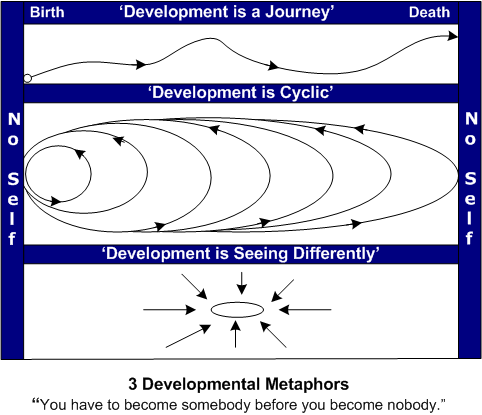
"We don't receive wisdom; we must discover it for ourselves after a journey that no one can take for us or spare us." Marcel Proust
"Two roads diverged in a wood, and I--I took the one less traveled by, And that has made all the difference." Robert Frost
"After enlightenment, the laundry". Zen saying
"We shall not cease from exploration. And the end of all our exploring will be to arrive where we started and know the place for the first time." T. S. Eliot
"First there are mountains, the there are no mountains, then there are mountains again." Zen saying
LJMap defines the prototypical categories accordingly:
Each of the 9 columns represent a different prototypical individual level developmental worldview.
Each of the 7 Customer Relationship Orientation columns represent a different prototypical group level developmental worldview.
Individual. Although the individual and group (organizational) path parallel each other and are measured by the same values they influenced by different underlying dynamics. For the individual, developmental growth is based on choice, opportunity, and recognition that human’s may also be influenced by an underlying natural or biological urge to grow. Goldstein (1938) asserts this based on his years of medical and biological work with neurologically diseased and injured patients and their organismic drive for recovery:
Group. Different Customer Relationship Orientations (CRO) correlate with different organizational cultures. What is important to note is that from a human commerce perspective no one of the CRO steps (2-7) is inherently better. Each is a legitimate relationship culture that can sustain task unity. Changing the culture to a more complex developmental stage can ruin the business. Or, failing to change to a more complex or less complex culture can ruin the business (Rackham & DeVincentis, 1998). There is no 'organizational development' imperative for group level developmental growth.
Different Developmental Dynamics. Using the developmental dynamics mapping presented earlier;
Although these two developmental paths appear congruent at the second level self-referential feedback loop- sustaining meaningful choice, their significant difference at the first level feedback loop - sustaining structural unity, makes them fundamentally different developmental dynamics.
Values paths are different avenues of meaningful development. They also help link the individual to others who have tread similar paths; leaders, teachers, counselors, etc. These paths are prototypical is that they define stages of development for a behavior that has observable steps of growing complexity, e.g. leadership, knowledge, empathy, expression.
A values path is a set of values that cross 3 or more developmental columns (steps). Usually with only one value or step per developmental column. Identifying specific values per developmental column that define a value path addresses the developmental questions: What are the steps of development? What are the antecedents ? The paths presented have not been validate in a systematic research manner, they have emerged from reviewing many value maps in coaching sessions with individuals. And, with more experience the paths presented may be adjusted, and I'm sure more paths will be identified.
Valid values paths tell compelling stories that link with the individual's behavior, awareness, feeling, and logic. One way to test or build a Values Path is to use each value and the words in its definition to tell a 'forward' or 'antecedent' story. Different paths may emerge according to cultural, gender, age, etc.? But, my assumption and growing experience is that truly valid paths are meaningful across many degrees of human difference.
Forward 'Expression Value Path' story:
Antecedent 'Expression Value Path' story:
Developmental Age Focus. Where most developmental theories and research focus on child development, the general category of focus for the Life Journey Map® is working adults. LJMap's equating 'use of word change' with 'developmental change' is supported by the developmental work of Gopnik and Meltzoff (1998, p 221); "We propose that language change may often lead to conceptual change rather than vice versa". Since LJMap's measurement is based on ones ability to read its age application has limits. It efficacy with reading children and teenagers has yet to be tested. The present norm study includes 2500 participants, 46% men, 54% women; average age = 44 years, stdev=10 years.
Quantitative & Qualitative Developmental Difference & Change. Individual and group value scores for all 130 values can be mapped onto the 7 Step Relationship Continuum and compared for peak % value score movement right or left. Highest scores per step, represent a prototypical developmental worldview. These percent scores represent basic level quantitative information. Each category title on the 7-Step Relationship Continuum provides a basic level qualitative information. These basic level prototypical terms allow you to orient very quickly to the individual's developmental worldview.
Specific level quantitative and qualitative data is accessible by looking at the actual rank scores given each value by the individual. It's only by looking at specific level data that you can notice values paths. It is important to note that no one naturally scores in only one developmental column. What this implies is that specific Field of Meaning values adjacent to the peaked column are instrumental in understanding developmental change (value paths) in both directions.
Specific level quantitative and qualitative values data as measured is presented in four different Life Journey Maps® 1) Summary Map, 2) Field of Meaning Map, 3) Physical-Feeling-Thinking Map, and 4) Conditional-Doing-Being-Career Maps. These same four maps also present group data in the same format.
Three samples of mapping developmental change over time, and one sample of mapping developmental difference are presented below. Without access to the specific level data you cannot fully appreciate qualitatively rich details and stories of developmental change and difference captured within these quantitative peaks and valleys. But, the peaks and valleys tell the coach where to look for meaningful stories.
Measuring Individual Developmental Change Over Time
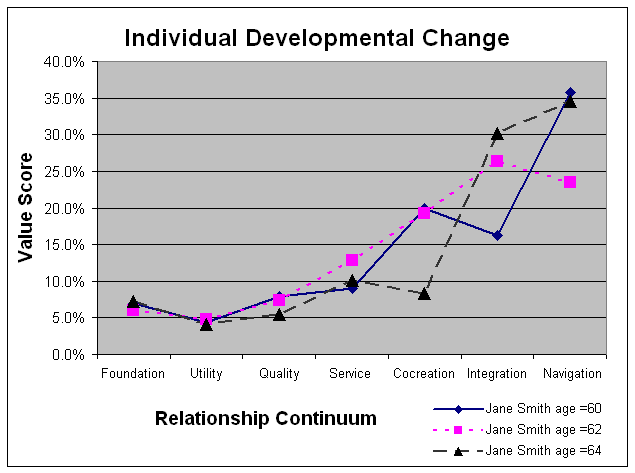
Change Sample 1: Over the past 4 years Jane Smith's map indicates change in her developmental worldview from Cocreation to Integration to Navigation. The 7-Step mapping shows quantitative change. But, more detailed review of the specific values that are changing over time is need to understand how these change in values reflects in her day to day change in problem solving.
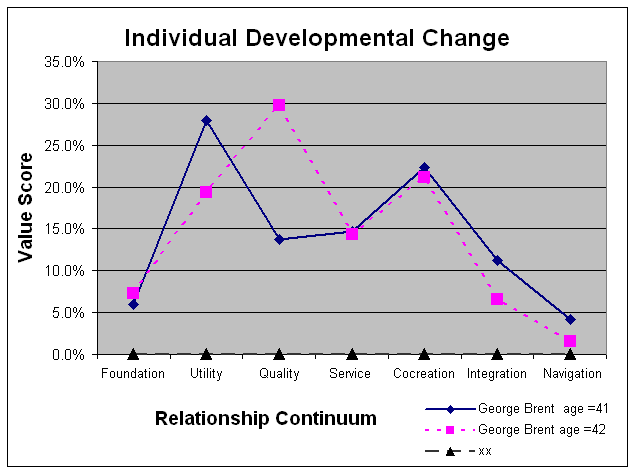
Change Sample 2: George is an experienced and successful Dr. who has recently changed his career focus to also being a CEO of a successfully growing medical clinic that he started with a group of colleagues. This is his first time in this role. A review of his specific values reveals that his change from Quality back to Utility reflects 'cycle-back' reintegrating new business values into his Field of Meaning that he initially did not develop in his professional training as a Dr.
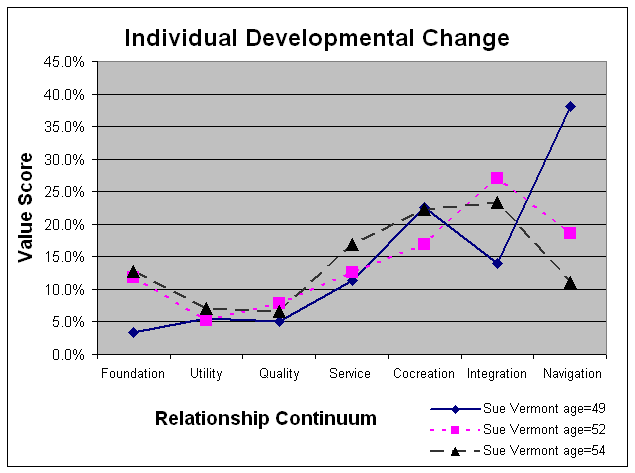
Change Sample 3 : Over the past 5 years Sue Vermont's graph indicates change in her developmental worldview from Cocreation to Integration. Closer review of qualitative data, specific values, show a change in her ranking of career values, from age 52 to 54 from a consultant to a leader of consultants. This reflects a professional transition she has being going through over this period. Again more detailed review of the specific values that are changing over time are needed to understand and coach this change in a qualitative manner.
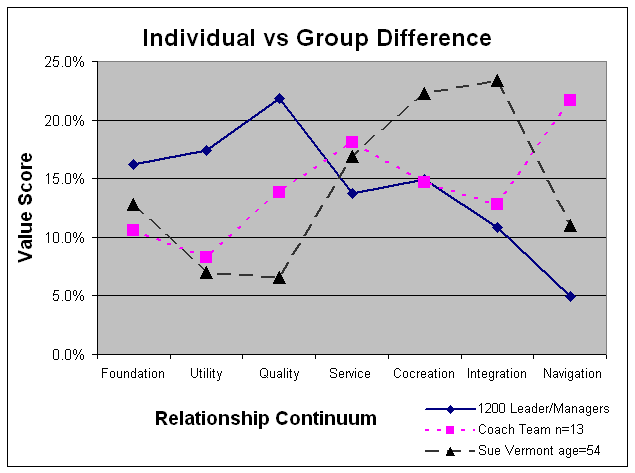
Difference Sample 4: In this mapping Sue Vermont, CEO of a consulting company she has recently formed, is compared to Coach Team (13 senior consultants) that make up her professional team. Sue has 20 (out of a possible 34) common Field of Meaning values with her team, both have 12 values in common with their customer's Field of Meaning (Norm data for 1200 leaders/managers). LJMap research indicates that in a high performing team members have 15-20 common Field of Meaning values. Sue and her team have 20 different value words that they can easily access in their joint problem solving and that have a high probability of generating shared meaning. But they only have 12 such value words as a group, common with their clients. In trying to create shared meaning and problem solving with their clients they are likely to be more intentional and strategic in their choice of value words.
Understand that the Coach Team's developmental world view is Service, which is adjacent to their clients (Leaders and Managers) whose developmental worldview is Quality. Adjacent developmental-worldviews have the capacity to work together. This consulting team will work well with clients who are trying to move their culture form Quality to Service. But they are not likely to be highly motivated when working with clients who are working on establishing Utility cultures or Quality cultures the are in a cycle back to Utility (re-establishing profit margins through efficiency, increased competitive selling, or re-implementing new legal standards).
Although the Coaches have a high Navigation score; a single peak preceded by a valley makes the peak aspirational. The Coach's integrated developmental worldview is Quality-Service-Cocreation. Sue's integrated developmental worldview is Service-Cocreation-Integration, thus a Service-Cocreation developmental spread links Sue with her team. But she is a meaning gap away from her clients, so she too needs to be strategic and intentional in terms of the value words she uses to connects with her business clients versus her consulting team.
Note that this whole analysis is at the basic level. Using the rules and relationships inherent in the prototypical concepts that describe the Customer Relationship Continuum, Shared Meaning, Meaning Gaps, Field of Meaning, etc.. But for Sue to work at the specific level she would need to look that 12 value words she has in common with her team. Or if she were working with an individual consultant, and an individual client, she would want to look at intersecting Fields of Meaning to understanding what value words are most like to create shared meaning and meaningful problem solving.
Copyright 2005 by Scott Bristol